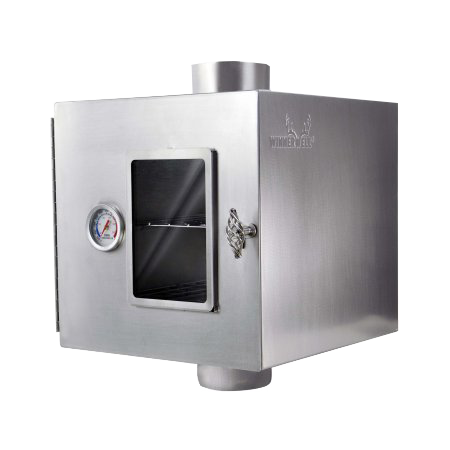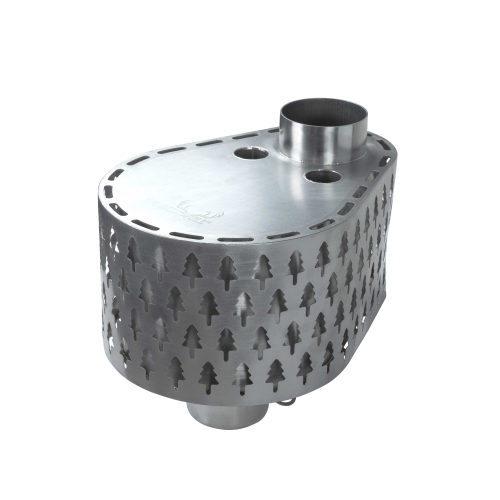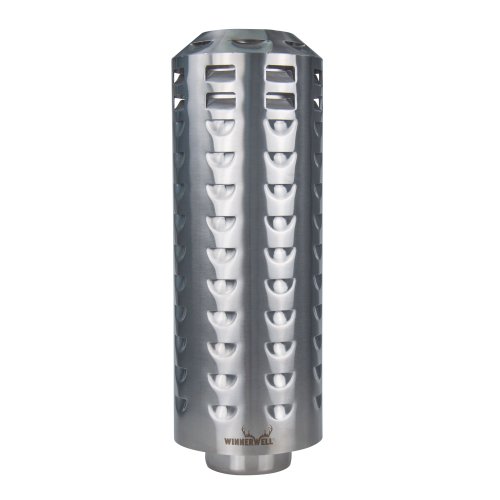Overview
The Winnerwell Nomad PLUS Double View External Air L-sized Wood Burning Tent Stove features a patented design with an external air intake from outside the tent. This unique design sets a new standard for heating efficiency in portable wood-burning stoves. By incorporating an inbuilt external air supply, the stove ensures an uninterrupted flow of fresh combustion air, eliminating cold drafts and preventing the stove from consuming the air within the tent and the hot air it has generated. The stove includes a secondary combustion system to burn off waste gases, enhancing heat production and reducing emissions.
Dimensions and Weight
- Firebox Dimension: 435(L)mm x 250(W)mm x 250(H)mm / 17.1(L)in x 9.8(W)in x 9.8(H)in
- Stowed Dimension: 600(L)mm x 315(W)mm x 325(H)mm / 23.6(L)in x 12.4(W)in x 12.8(H)in
- Assembly Dimension: 600(L)mm x 650(W)mm x 2620(H)mm / 23.6(L)in x 25.6(W)in x 103.1(H)in
- Pipe Diameter: 89mm / 3.5in
- Spark Arrestor: 89(D)mmx316(H)mm / 3.5(D)inx12.4(H)in
- Total Pipe Length: 2230mm / 87.8in
- Net Weight: 17.1kg / 37.6lbs
Includes
- 1 stove body
- a set of sections of straight chimney pipe
- 1 airflow controller
- 1 spark arrestor
- 1 ash scraper and 1 grate.
Features
The Nomad PLUS Double View External Air L-sized boasts several advanced features to enhance your outdoor experience:
- Patented External Air Intake. The stove incorporates a unique patented design with an external air intake from outside the tent. This innovation ensures an uninterrupted flow of fresh combustion air, eliminating cold drafts and significantly improving heating efficiency compared to traditional stoves.
- Secondary Combustion System. Equipped with a secondary combustion system, this stove goes beyond the basics. It efficiently burns off waste gases, not only producing more heat but also contributing to a cleaner and eco-friendly burning process by reducing harmful emissions.
- Versatile Dimensions. The stove's carefully designed dimensions make it adaptable to various tent sizes. Whether you're camping solo or with a group, the Winnerwell Nomad PLUS provides efficient heating without compromising on portability or performance.
- Spark Arrestor for Safety. Prioritizing safety, the stove comes with a spark arrestor. This additional feature helps prevent accidental sparks or embers from escaping the stove during operation, minimizing the risk of fire hazards in outdoor settings.
- Durable AISI304 Stainless Steel Construction. Crafted from premium AISI304 stainless steel, this stove ensures exceptional durability and resistance to the elements. The high-quality material not only extends the stove's lifespan but also enhances its ability to withstand the rigors of diverse outdoor environments.
Material Advantage
Tent Stove stands out with its material advantage, utilizing AISI304 stainless steel for enhanced performance and longevity. Winnerwell prioritizes quality and durability, and the choice of AISI304 stainless steel for constructing this stove reflects these principles. Here's why this material is advantageous:
- Corrosion Resistance. AISI304 stainless steel is renowned for its exceptional corrosion resistance. This property is crucial for outdoor equipment exposed to varying weather conditions. The stove remains unaffected by rust and corrosion, ensuring a longer lifespan and reliable performance even in challenging environments.
- High Temperature Tolerance. Camping stoves, by nature, are subjected to high temperatures during operation. AISI304 stainless steel can withstand these elevated temperatures without compromising its structural integrity. This capability allows for a robust stove design that maintains its functionality over repeated use.
- Sturdy Construction. The material's inherent strength allows for the creation of a sturdy and reliable stove. This is particularly important for camping equipment that may encounter rough handling or uneven terrains. The stove's structural integrity ensures it can withstand the demands of outdoor adventures.
- Easy Maintenance. AISI304 stainless steel is known for its ease of maintenance. It's resistant to staining and is relatively simple to clean, ensuring that your stove can be kept in optimal condition with minimal effort, even after extended use in the great outdoors.
- Attractive Patina Development. After the initial use, the stainless steel surface begins to develop a pleasing patina. This natural transformation not only adds aesthetic appeal but also serves as a protective layer, further enhancing the material's resistance to environmental factors.
Accessory Recommendations
To enhance the functionality and versatility of the Tent Stove, consider these accessory recommendations tailored to elevate your outdoor cooking and heating experience:
|
|
 |

|

|
.png)
|
|
Winnerwell's L-sized Water Tank: Compact, durable, and the ideal companion for your camping stove. Instantly heat water for easy tea or coffee preparation, elevating your outdoor cooking experience with convenience. |
Winnerwell's Pipe Oven 3.5':Compact, efficient, and the perfect complement to your camping stove. Elevate your outdoor cooking game effortlessly and bake your favorite foods on the go. |
Winnerwell's 3.5' Secondary Combustion Burner:Elevate your camping stove with enhanced efficiency and reduced emissions. Compact and powerful, it not only boosts performance but also adds extra cooking space on the go. |
Winnerwell's 3.5-inch Heat Protector Chimney:This small add-on will increase the safety of your camping stove. The triple wall design prevents the hot flue pipe from directly touching your exit point. |
Winnerwell's Flashing Kit Large:Crafted from high-temperature-resistant silicone, it creates a weather-tight seal with stainless steel rings and wing nuts. Perfect for existing stove jacks or new installations, ensuring durability in any outdoor setting. |
Installation Guidelines
Proper installation is crucial to maximizing the performance and safety of the tent stove. Follow these recommendations for a smooth and effective installation process:
- Before installation, assess the ventilation requirements of your tent or shelter. Ensure there is sufficient space and a dedicated stove jack for the flue pipe, allowing for the safe and efficient expulsion of combustion by-products.
- Position the stove on a stable and level platform within your tent. This not only ensures safety during operation but also aids in maintaining the stove's stability, preventing accidental tip-overs.
- Assemble the chimney sections according to the dimensions of your tent or shelter. Follow the manufacturer's guidelines for securing and connecting chimney components, and consider adding additional sections for taller tents.
- Orientate the flue pipe to minimize any interference with the tent structure. Proper orientation prevents hot surfaces from coming into contact with the tent fabric, reducing the risk of damage.
- Employ heat-resistant mats or shields beneath the stove and adjacent to the stovepipe. This protects the tent floor and surrounding areas from excessive heat, ensuring a safe and controlled heating environment.
- Adhere to recommended clearance distances between the stove and combustible materials. Maintaining proper clearances prevents the risk of fire and ensures the longevity of both the stove and the tent.
- Use appropriate fasteners or brackets to secure the stove in place, preventing unintended movement or displacement during use. This is particularly important in situations where the terrain may be uneven.
- Seal any unnecessary tent openings or gaps to retain warmth and prevent drafts. This is especially critical in cold weather conditions, as it contributes to the stove's overall heating efficiency.
FAQs
How does the external air intake improve heating efficiency?
The external air intake ensures an unlimited flow of fresh combustion air, eliminating cold drafts and preventing the stove from consuming the tent's air.
Can the stove be used in airtight tents?
Operating a stove in an airtight tent without external air intake can quickly deplete oxygen, presenting serious problems for occupants.
What is the purpose of the secondary combustion system?
The secondary combustion system burns off waste gases, producing more heat and reducing emissions.
Will the stove's top surface deform over time?
A certain deformation may occur, but it does not affect the stove's normal use.
Is the change in color of the stainless steel after the first burn normal?
Yes, the change in color is a normal patina development and not corrosion.
